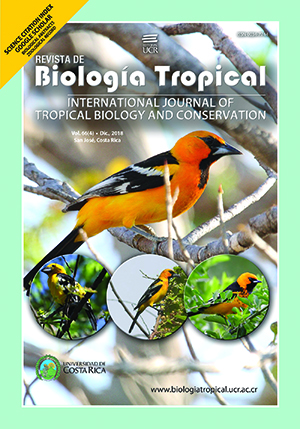Resumen
La defensa química es un mecanismo que se encuentra presente en varios animales y plantas. Sin embargo, pocos casos son conocidos para especies de aves. En este estudio evaluamos la toxicidad de extractos de plumas de Pheucticus chrysopeplus con un ensayo de letalidad utilizando artemia (Artemia salina) como modelo in vivo. La mortalidad de A. salina se evaluó luego de ser expuesta por 24 horas a agua marina artificial, metanol y extracto metanólico de plumas de P. chrysopeplus. La prueba de Kruskal-Wallis mostró que existe una diferencia significativa entre los porcentajes de mortalidad de los tratamientos evaluados (X2 = 65.25, P < 0.0001, n = 50). Con esto, describimos a P. chrysopeplus como la primera especie de ave tóxica reportada para Guatemala y Centroamérica, resaltando la importancia de su conservación, así como la identificación de la sustancia tóxica presente en sus plumas. También destacamos el posible mecanismo de mimetismo que podría estar ocurriendo entre P. Chrysopeplus y dos especies simpátricas de orioles (Icterus pectoralis e I. pustulatus).
Citas
Ariano-Sánchez, D., & Salazar, G. (2015). Spatial ecology of the endangered Guatemalan Beaded Lizard Heloderma charlesbogerti (Sauria: Helodermatidae), in a tropical dry forest of the Motagua Valley, Guatemala. Mesoamerican Herpetology, 2(1), 64-74.
Audesirk, T., Audesirk, G., & Byers, B. (2003). Biología. La vida en la Tierra. México D.F.: Pearson Educación.
Bartram, S., & Boland, W. (2001). Chemistry and Ecology of Toxic Birds. ChemBioChem, 2, 809-811.
CONAP. (2009). Lista de especies amenazadas (LEA) y Listado de flora y fauna silvestres CITES de Guatemala. Guatemala: Departamento de vida silvestre - CONAP.
Dumbacher, J., Beehler, B., Spande, T., Garraffo, H., & Daly, J. (1992). Homobatrachotoxin in the genus Pitohui: Chemical defense in birds? Science, 258, 799-801.
Dumbacher, J., & Fleischer, R. (2001). Phylogenetic evidence for colour pattern convergence in toxic pitohuis: Mülerian mimicry in birds? Proceedings of the Royal Society of London, 268, 1971-1976.
Dumbacher, J. P., Menon, G. K., & Daly, J. W. (2009). Skin as a toxin storage organ in the endemic New Guinean Genus Pitohui. The American Ornithologists’ Union, 126(3), 520-530.
Fagan, J., & Komar, O. (2016). Field Guide to Birds of Northern Central America. New York: Peterson Field Guides.
FAO. (2007). Wild birds and avian influenza. Rome, Italy: FAO.
Geethaa, S., Jayanthi, P., Poh, S., & Ming, O. (2013). Interference from ordinarily used solvents in the outcomes of Artemia salina lethality test. Journal of Advanced Pharmaceutical Technology & Research, 4(4), 179-182.
Gopalakrishnakone, P. (2015). Toxinology. New York: Springer.
Hamidi, M., Jovanova, B., & Kadifkova, T. (2014). Toxicological evaluation of the plant products using Brine Shrimp (Artemia salina L.) model. Macedonian Pharmaceutical Bulletin, 60(1), 9-18.
Omland, K., & Lanyon, S. (2000). Reconstructing plumage evolution in orioles (Icterus): repeated convergence and reversal in patterns. Evolution, 54(6), 2119-2133.
Price, J., Friedman, N., & Omland, K. (2007). Song and plumage evolution in the new world orioles (Icterus) show similar lability and convergence in patterns. Evolution, 61(4), 850-863.
Savitzky, A., Mori, A., Hutchinson, D., Saporito, R., Burghardt, G., Lillywhite, H., & Meinwald, J. (2012). Sequestered defensive toxins in tetrapod vertebrates: principles, patterns, and prospects for future studies. Chemoecology, 22, 141.
Skelhorn, J., & Rowe, C. (2007). Predators’ toxin burdens influence their strategic decisions to eat toxic prey. Current Biology, 17, 1479-1483.
UCLA. (2015). Feather sampling protocol. California: University of California.
Weldon, P. J. (2000). Avian chemical defense: Toxic Birds not of a feather. PNAS, 97(24), 12948-12949.
Wilsdon, C. (2009). Animal behavior. New York: Chelsea House Publishers.
Wu, C. (2014). An important player in brine shrimp lethality bioassay: The solvent. Journal of Advanced Pharmaceutical Technology & Research, 5(1), 57-58.
##plugins.facebook.comentarios##

Esta obra está bajo una licencia internacional Creative Commons Atribución 4.0.
Derechos de autor 2018 Revista de Biología Tropical


